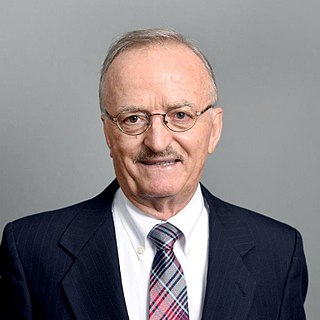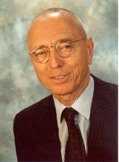
Heinrich Rudolf Hertz was a German physicist who first conclusively proved the existence of the electromagnetic waves predicted by James Clerk Maxwell's equations of electromagnetism. The unit of frequency, cycle per second, was named the "hertz" in his honor.

Constantine A. Balanis is a Greek-born American scientist, educator, author, and Regents Professor at Arizona State University. Born in Trikala, Greece on October 29, 1938. He is best known for his books in the fields of engineering electromagnetics and antenna theory. He emigrated to the United States in 1955, where he studied electrical engineering. He received United States citizenship in 1960.
John Daniel Kraus was an American physicist and electrical engineer known for his contributions to electromagnetics, radio astronomy, and antenna theory. His inventions included the helical antenna, the corner reflector antenna, and several other types of antennas. He designed the Big Ear radio telescope at Ohio State University, which was constructed mostly by a team of OSU students and was used to carry out the Ohio Sky Survey. Kraus held a number of patents and published widely.
Leopold B. Felsen was a electrical engineer and physicist known for studies of Electromagnetism and wave-based disciplines. He had to flee Germany at 16 due to the Nazis. He has fundamental contributions to electromagnetic field analysis.
James R. Wait was a Canadian electrical engineer and engineering physicist. In 1977, he was elected as a member of National Academy of Engineering in Electronics, Communication & Information Systems Engineering for his contributions to electromagnetic propagation engineering as it affects communication and geophysical exploration.
Ronold Wyeth Percival King was an American applied physicist and electrical engineer, known for his contributions to the theory and application of microwave antennas. He published twelve books and over three hundred articles in his area, as well as mentored one hundred doctoral dissertations.
Richard W. Ziolkowski is an American electrical engineer and academician, who was the president of the IEEE Antennas and Propagation Society (2005), and a former vice president of this same society (2004). In 2006, he became an OSA Fellow. He is also an IEEE Fellow. He was born on November 22, 1952, in Warsaw, New York.
Microwave engineering pertains to the study and design of microwave circuits, components, and systems. Fundamental principles are applied to analysis, design and measurement techniques in this field. The short wavelengths involved distinguish this discipline from electronic engineering. This is because there are different interactions with circuits, transmissions and propagation characteristics at microwave frequencies.

Adrianus Teunis (Aad) de Hoop is a Dutch electrical engineer, mathematician, and physicist, and professor emeritus at Delft University of Technology. De Hoop's research interests are in the broad area of wavefield modeling in acoustics, electromagnetics, and elastodynamics. Other research includes a method for computing pulsed electromagnetic fields in strongly heterogeneous media with applications to integrated circuits, and a methodology for time-domain pulsed-field antenna analysis, design, and optimization for mobile communication and radar applications.
Robert Emmanuel Collin was a Canadian American electrical engineer, university professor and life fellow of the IEEE. Collin was elected to the National Academy of Engineering in 1990.

Weng Cho Chew is a Malaysian-American electrical engineer and applied physicist known for contributions to wave physics, especially computational electromagnetics. He is a Distinguished Professor of Electrical and Computer Engineering at Purdue University.
Roger Fuller Harrington is an American electrical engineer and professor emeritus at Syracuse University. He is best known for his contributions to computational electromagnetics with his development of method of moments (MoM). Harrington's 1968 book, Field Computation by Moment Methods, is regarded as a pivotal textbook on the subject.
Yuen Tze Lo was a Chinese American electrical engineer and academician. He was a professor emeritus at the Department of Electrical and Computer Engineering at University of Illinois at Urbana–Champaign. He is best known for his contributions to the theory and design of antennas. He is the editor of the textbook series, Antenna Handbook.

Douglas Henry Werner is an American scientist and engineer. He holds the John L. and Genevieve H. McCain Chair Professorship in the Penn State Department of Electrical Engineering and is the director of the Penn State University Computational Electromagnetics and Antennas Research Laboratory. Werner holds 20 patents and has over 1090 publications. He is the author/co-author of 8 books. According to Google Scholar, his h-index is 77 with more than 25,600 citations. He is internationally recognized for his expertise in electromagnetics, antenna design, optical metamaterials and metamaterial-enabled devices as well as for the development/application of inverse-design techniques.
Georges Armand Deschamps was a French American engineer and Professor Emeritus at the Department of Electrical Engineering at University of Illinois at Urbana-Champaign. He is best known for his contributions to electromagnetic theory, microwave engineering and antenna theory. He is also regarded as an early pioneer of microstrip and patch antennas, which he proposed in 1953.
Arthur Aaron Oliner was an American physicist and electrical engineer, who was professor emeritus at department of electrical and computer engineering at New York University-Polytechnic. Best known for his contributions to engineering electromagnetics and antenna theory, he is regarded as a pioneer of leaky wave theory and leaky wave antennas.
Akira Ishimaru is a Japanese-American electrical engineer and professor emeritus at Department of Electrical and Computer Engineering at University of Washington. He is best known for his contributions to the theory of wave scattering in random media.
Jean van Bladel was a Belgian electrical engineer, physicist and academician, who was a Professor Emeritus at Ghent University. He was best known for his contributions to electromagnetics and antenna theory.




